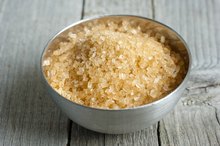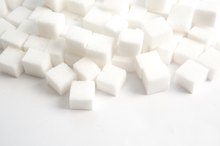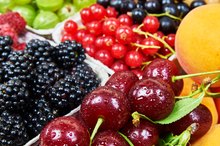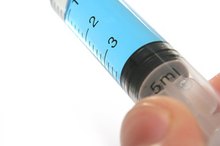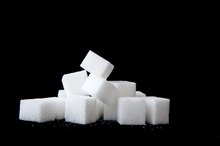What does fact checked mean?
At Healthfully, we strive to deliver objective content that is accurate and up-to-date. Our team periodically reviews articles in order to ensure content quality. The sources cited below consist of evidence from peer-reviewed journals, prominent medical organizations, academic associations, and government data.
The information contained on this site is for informational purposes only, and should not be used as a substitute for the advice of a professional health care provider. Please check with the appropriate physician regarding health questions and concerns. Although we strive to deliver accurate and up-to-date information, no guarantee to that effect is made.
Physical Characteristics of Glucose
Physical characteristics determine whether the glucose molecule can be metabolized for energy and how it affects your health. When some characteristics of a glucose molecule change, it actually becomes a different sugar. And when you cook, several different qualities determine the way your dishes turn out.
Molecular Shape
Glucose exists in a variety of shapes, and the two most basic are L-glucose and D-glucose 4. Both forms have the same chemical composition, but their component particles are arranged as mirror images of one another.
These different shapes, called isomers, are significant characteristics because they determine how the sugar works inside your body. D-glucose, also known as dextrose, is a simple sugar that naturally occurs in carbohydrates and helps fuel your body 4. L-glucose is also a simple sugar, but your body can't metabolize it for energy.
Glucose can also form a ring-shaped structure that has two additional isomers. However, these forms connect together to form large molecules of starch and cellulose, complex carbs with different properties than L-glucose 2.
- Glucose exists in a variety of shapes, and the two most basic are L-glucose and D-glucose 4.
- D-glucose, also known as dextrose, is a simple sugar that naturally occurs in carbohydrates and helps fuel your body 4.
Size and Solubility
Foods Containing Glucose or Fructose
Learn More
L-glucose is a tiny molecule, even smaller than a red blood cell or the thin membrane that surrounds cells. It also dissolves in water. Both of these characteristics are vital when it comes to your health. They allow glucose to be rapidly digested, absorbed into the bloodstream and easily carried through water-based body fluid.
The molecule's size and solubility helps give you quick boost of energy after you consume glucose-containing carbohydrates, such as grains and fruits 1. On the other hand, these characteristics also mean glucose can spike blood sugar, which can lead to weight gain and cause health problems if you’re diabetic.
- L-glucose is a tiny molecule, even smaller than a red blood cell or the thin membrane that surrounds cells.
- On the other hand, these characteristics also mean glucose can spike blood sugar, which can lead to weight gain and cause health problems if you’re diabetic.
Sweet-Tasting Powder
Glucose is a white, sweet-tasting powder, so it can be used as a sweetener, but it’s usually combined with other sugars. On a relative sweetness scale, glucose has a score of 0.74, compared to fructose, with a rating of 1.74. They’re combined in equal amounts to make sucrose, or table sugar, which has a sweetness level of 1.
Glucose and fructose have the same amount of carbon, oxygen and hydrogen, but in each sugar, the particles are arranged into slightly different shapes. The unique shapes determine whether it’s fructose or glucose, as well as the level of sweetness.
- Glucose is a white, sweet-tasting powder, so it can be used as a sweetener, but it’s usually combined with other sugars.
- They’re combined in equal amounts to make sucrose, or table sugar, which has a sweetness level of 1.
Impact in Cooking
Carbohydrates and Fiber in Onions
Learn More
Several physical characteristics of glucose, as well as sucrose and other sugars, affect their role in food preparation. Along with the obvious benefit of boosting sweetness, the sweet characteristic of sugar improves or diminishes other flavors. For example, sugar is added to tomato sauce to reduce its acidic flavor.
Sugar’s solubility and tendency to absorb water help tenderize yeast-based dough and add thickness to beverages. Its freezing point prevents crystals from developing in frozen foods. The melting point of glucose, fructose and sucrose is especially important in cooking. As sugars reach their melting point, they caramelize, contributing brown coloring and depth of flavor.
- Several physical characteristics of glucose, as well as sucrose and other sugars, affect their role in food preparation.
- The melting point of glucose, fructose and sucrose is especially important in cooking.
Related Articles
References
- University of Bristol: Molecule of the Month: Glucose
- Science of Cooking: Molecules of Taste – Glucose
- Intermediate Physics for Medicine and Biology; Russell Hobbie and Bradley Roth
- PubChem: D-Glucose
- University of Illinois: Taste Receptors
- Canadian Sugar Institute: Functional Properties of Sugar
- National Institute of Diabetes and Digestive and Kidney Diseases. Diabetes diet, eating, & physical activity. Published December 2016.
- American Diabetes Association. The big picture: Checking your blood glucose.
- American Diabetes Association. 6. Glycemic Targets: Standards of Medical Care in Diabetes-2020. Diabetes Care. 2020;43(Suppl 1):S66-S76. doi:10.2337/dc20-S006
- American Diabetes Association. 14. Management of diabetes in pregnancy: Standards of medical care in diabetes-2020. Diabetes Care. 2020;43(Suppl 1):S183-S192. doi:10.2337/dc20-S014
- Porcellati F, Lucidi P, Bolli GB, Fanelli CG. Thirty years of research on the dawn phenomenon: Lessons to optimize blood glucose control in diabetes. Diabetes Care. 2013;36(12):3860-2. doi:10.2337/dc13-2088
- American Diabetes Association. 5. Lifestyle management: Standards of medical care in diabetes-2019. Diabetes Care. 2019;42(Suppl 1):S46-60. doi:10.2337/dc19-S005
- Colberg SR, Sigal RJ, Yardley JE, et al. Physical activity/exercise and diabetes: A position statement of the American diabetes association. Diabetes Care. 2016;39(11):2065-2079. doi:10.2337/dc16-1728
- American Diabetes Association (ADA). Understanding A1C.
- Garber AJ, Abrahamson MJ, Barzilay JI, et al. Consensus statement by the American association of clinical endocrinologists and American college of endocrinology on the comprehensive type 2 diabetes management algorithm - 2019 executive summary. Endocr Pract. 2019;25(1):69-100. doi:10.4158/CS-2018-0535
Writer Bio
Sandi Busch received a Bachelor of Arts in psychology, then pursued training in nursing and nutrition. She taught families to plan and prepare special diets, worked as a therapeutic support specialist, and now writes about her favorite topics – nutrition, food, families and parenting – for hospitals and trade magazines.
